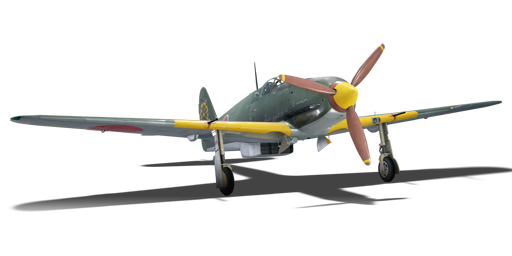



This Ki-61-I hei, designated as the Type 3 Fighter (三式戦闘機), was flown by pilot Takeichi Tada of the 78th Sentai. The 78th Sentai was initially formed in 1942 in Manchuria, equipped with Ki-27s. In April 1943, the unit was recalled to Akeno Airbase, Japan, where they were the 2nd Squadron transitioned to the Ki-61 after intense training. The unit's insignia, eight stylized 7s forming a chrysanthemum, symbolized "78". After training, the squadron was deployed to Rabaul in June 1943, where they camouflaged their Ki-61s, removing the unit insignia and painting tail lines in white, yellow, or blue to distinguish the Chutai (flight groups). The 78th Sentai earned the distinction of securing the first aerial victory with the Ki-61 and flew defensive missions over Rabaul until the unit was effectively destroyed and disbanded by July 1944.
Introduced in Update "Starfighters", the Ki-61-I hei retains the excellent manoeuvrability typical of Japanese aircraft but has some limitations. Its top speed is only marginally higher than early "Zeroes", and while it accelerates well and maintains energy, it falls behind other aircraft in overall speed, resembling the German Bf 109 G-6. The armament is deadly, featuring two MG 151 20 mm cannons with German Minengeschoß shells for devastating firepower, paired with Japanese 12.7 mm guns equipped with HE shells. Although the ammo count is average, it's less than that of American aircraft. The effective landing flaps aid in slowing down during combat, allowing for overshoots. The Hei Hien can also carry various bombs, with the 250 kg loadout being the most effective. For air combat, air target belts for the MG 151s, packed with Minengeschoß shells, and stealth or air target belts for the 12.7 mm guns are recommended.
flaps
flaps
flaps
brake
| Belt | Belt filling | Armor penetration (mm) at a distance: | |||||
|---|---|---|---|---|---|---|---|
| 10 m | 100 m | 500 m | 1000 m | 1500 m | 2000 m | ||
| IT/IT/APHE/HEI | 21 | 19 | 8 | 3 | 1 | 1 | |
| IT/HEI/HEI/AP-I | 27 | 24 | 14 | 7 | 3 | 2 | |
| AP-I/HEI/HEI/HEI/HEI/IT | 27 | 24 | 14 | 7 | 3 | 2 | |
| APHE/APHE/APHE/IT | 21 | 19 | 8 | 3 | 1 | 1 | |
| FI-T/FI-T/FI-T/IT/IT | 21 | 19 | 8 | 3 | 1 | 1 | |
| HEI/HEI/HEI/APHE/AP-I | 27 | 24 | 14 | 7 | 3 | 2 | |
| Belt | Belt filling | Armor penetration (mm) at a distance: | |||||
|---|---|---|---|---|---|---|---|
| 10 m | 100 m | 500 m | 1000 m | 1500 m | 2000 m | ||
| AP-T/AP/HEF-I | 21 | 19 | 13 | 7 | 4 | 3 | |
| AP-T/HEF-I/AP/HEF-I | 21 | 19 | 13 | 7 | 4 | 3 | |
| AP-T/HEF-I/HEF-I/HEF-I | 21 | 19 | 13 | 7 | 4 | 3 | |
| AP-T/AP/AP-T | 21 | 19 | 13 | 7 | 4 | 3 | |
| AP/HEF-I/HEF-I/HEF-I | 21 | 19 | 13 | 7 | 4 | 3 | |







 2 x (85 / 235 / 420) %
2 x (85 / 235 / 420) % 
 2 x 160 %
2 x 160 % 

Flight performance | |
|---|---|
Survivability |
|---|
Weaponry | |
|---|---|